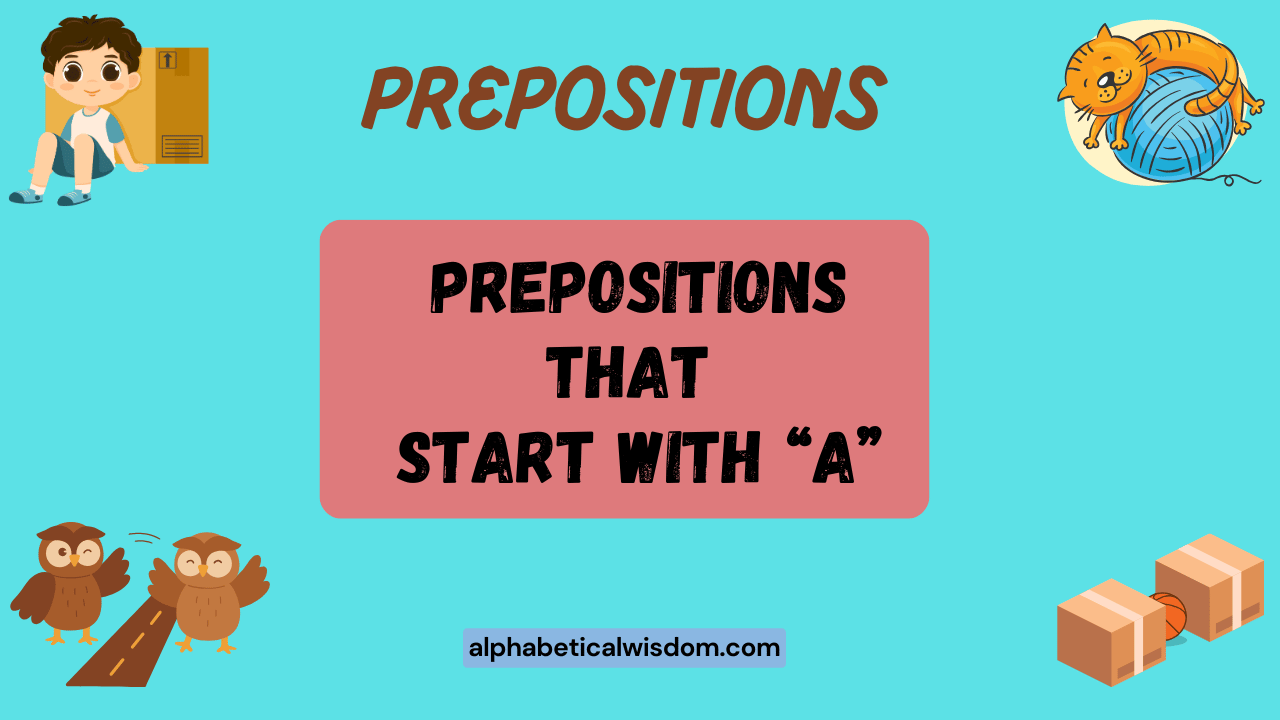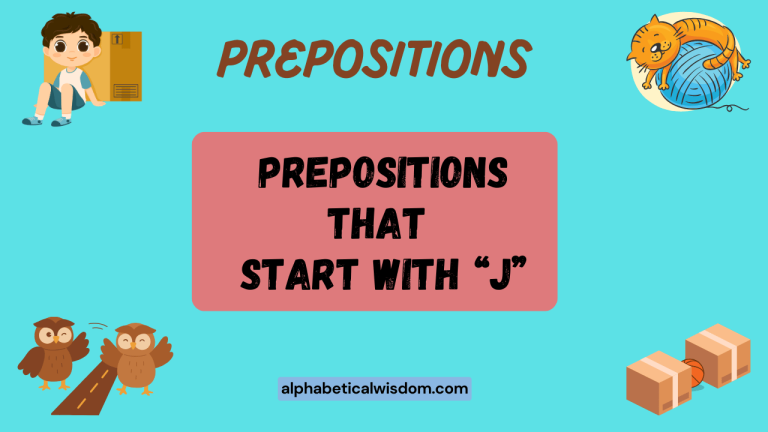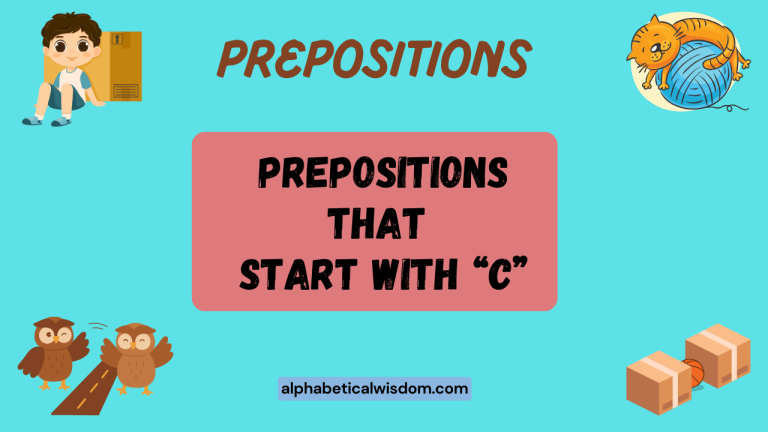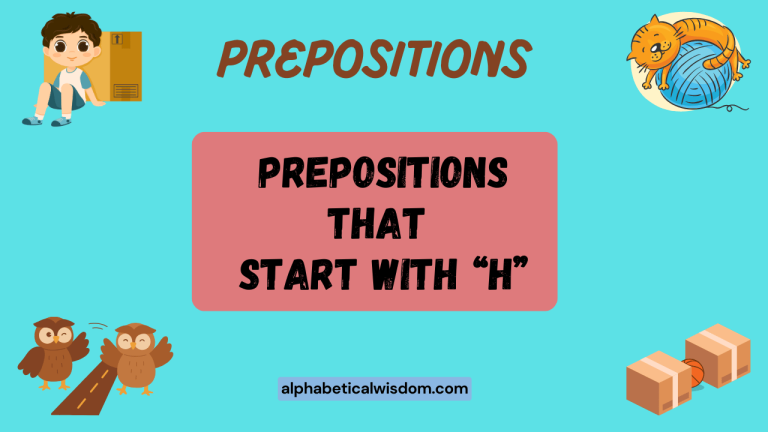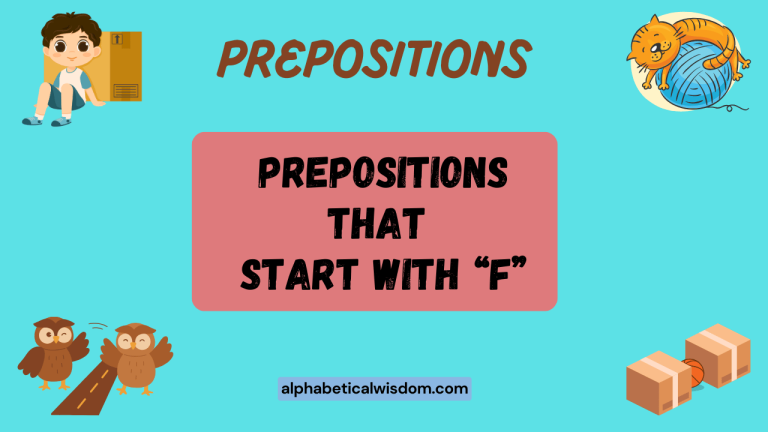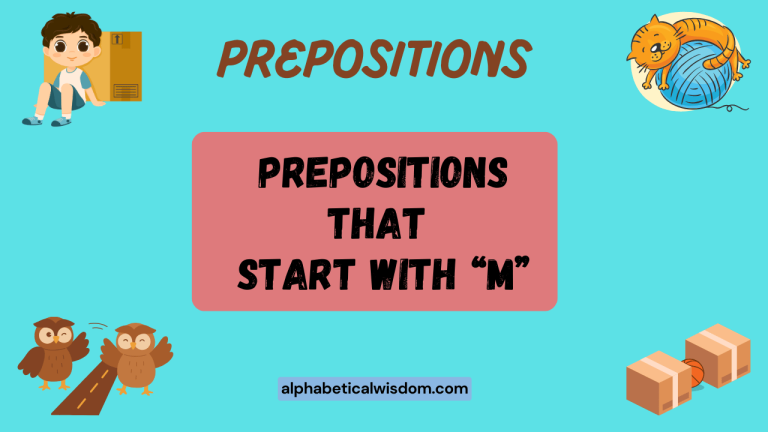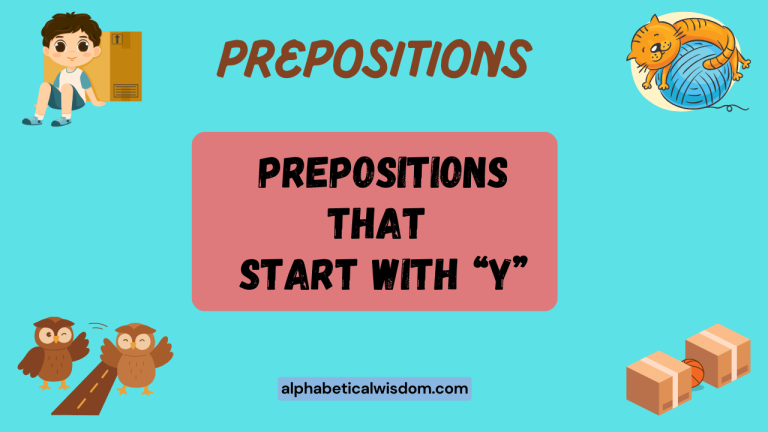Mastering Prepositions: A Comprehensive Guide to Prepositions Starting with ‘A’
Prepositions are essential components of the English language, acting as the glue that connects words and phrases, providing crucial context and clarity. Understanding prepositions, particularly those starting with the letter ‘A’, is vital for constructing grammatically correct and meaningful sentences.
This guide provides a comprehensive exploration of prepositions beginning with ‘A’, covering their definitions, structural roles, usage rules, common errors, and practical exercises. Whether you’re an English language learner or a seasoned writer aiming for precision, this article will equip you with the knowledge and skills to confidently use these prepositions.
This article is designed for English language learners of all levels, from beginners to advanced speakers, as well as teachers and writers who want to deepen their understanding of English grammar. By mastering these prepositions, you can enhance the clarity and accuracy of your writing and speaking.
Table of Contents
- Definition of Prepositions Starting with ‘A’
- Structural Breakdown
- Types and Categories
- Examples
- Usage Rules
- Common Mistakes
- Practice Exercises
- Advanced Topics
- FAQ
- Conclusion
Definition of Prepositions Starting with ‘A’
A preposition is a word that shows the relationship between a noun or pronoun and other words in a sentence. Prepositions typically indicate location, direction, time, or manner.
Prepositions starting with ‘A’ are a subset of these words, each carrying specific meanings and usage patterns. They are crucial for building complex sentences and conveying precise information.
These prepositions are invariable, meaning they do not change form regardless of the noun or pronoun they precede.
Prepositions function as connectors, linking nouns or pronouns (their objects) to other elements within the sentence. They add descriptive detail and provide context, enabling clearer and more effective communication.
Recognizing and correctly using prepositions, especially those starting with ‘A’, is a key aspect of English grammar proficiency.
Structural Breakdown
The basic structure involving a preposition is quite straightforward: Preposition + (Optional Modifiers) + Noun Phrase. The noun phrase, also known as the object of the preposition, can be a single noun, a pronoun, or a more complex phrase. The optional modifiers can be adjectives or adverbs that further describe the noun phrase.
Consider the following examples to illustrate this structure:
- Above the clouds (Preposition + Noun Phrase)
- About a specific topic (Preposition + Noun Phrase)
- Across the wide river (Preposition + Modifier + Noun Phrase)
- After the long meeting (Preposition + Modifier + Noun Phrase)
Prepositional phrases, which include the preposition and its object, can function as adjectives or adverbs within a sentence, adding detail and clarifying relationships between different parts of the sentence. Recognizing this structure can help in understanding and constructing grammatically correct sentences.
Types and Categories
Prepositions starting with ‘A’ can be categorized based on their primary function or the type of relationship they express. While some prepositions can fit into multiple categories depending on the context, this classification provides a useful framework for understanding their diverse uses.
Above
Above indicates a position that is higher than something else. It often implies a sense of being over or on top of. It refers to spatial relationships, indicating that one thing is at a higher level than another.
Examples:
- The plane flew above the clouds.
- The temperature is above average today.
- He hung the painting above the fireplace.
About
About has multiple meanings, including “concerning,” “approximately,” or “around.” It can refer to a subject matter, a quantity, or a general location.
Examples:
- The book is about the French Revolution.
- There were about fifty people at the party.
- He was wandering about the town.
Across
Across indicates movement or position from one side to the other. It suggests traversing a space or boundary.
Examples:
- They walked across the bridge.
- The store is just across the street.
- She drew a line across the page.
After
After indicates a time following a particular event or point. It can also refer to the order or sequence of events.
Examples:
- We will leave after lunch.
- After the storm, the sun came out.
- She arrived after everyone else.
Against
Against indicates opposition, contact, or contrast. It can refer to physical contact, resistance, or disagreement.
Examples:
- He leaned against the wall.
- They fought against the enemy.
- She argued against the proposal.
Along
Along indicates movement or position in a line or path. It suggests following a route or being situated on a particular course.
Examples:
- They walked along the beach.
- The trees are planted along the road.
- He carried his bag along with him.
Among
Among indicates being surrounded by or included within a group. It suggests being part of a larger collection.
Examples:
- She felt safe among her friends.
- The book is among the bestsellers.
- There was a thief among them.
Around
Around indicates being located in a circular or encompassing area. It can also mean “approximately” or “in the vicinity of.”
Examples:
- They sat around the campfire.
- It costs around $50.
- He looked around the room.
As
As has various meanings, including “in the role of,” “while,” or “because.” It can indicate a function, a simultaneous action, or a reason.
Examples:
- She works as a teacher.
- As he walked, he sang a song.
- As it was raining, we stayed inside.
At
At indicates a specific point in time or location. It is used to denote precise moments, addresses, or positions.
Examples:
- We will meet at 3 PM.
- She lives at 123 Main Street.
- He is at the library.
According to
According to indicates that information is being reported from a particular source or authority. It’s used to attribute statements, beliefs, or facts.
Examples:
- According to the news, there will be a storm.
- According to my doctor, I need more exercise.
- According to the manual, this is how it works.
Ahead of
Ahead of indicates being in front of something or someone else, either in terms of physical position, time, or progress.
Examples:
- He is ahead of the competition.
- We need to plan ahead of time.
- The runner is ahead of the pack.
Apart from
Apart from means “except for” or “besides.” It indicates an exclusion or exception to a general statement.
Examples:
- Apart from the weather, the trip was great.
- Apart from John, everyone is here.
- Apart from a few scratches, the car is fine.
Aside from
Aside from is similar to “apart from” and also means “except for” or “besides.” It indicates an exclusion or exception to a general statement.
Examples:
- Aside from the noise, the apartment is perfect.
- Aside from Mary, no one knew the answer.
- Aside from the cost, it’s a great product.
Examples
To further illustrate the usage of prepositions starting with ‘A’, the following tables provide various examples categorized by preposition.
The following table illustrates the usage of the preposition “Above” in different contexts.
| Sentence | Context |
|---|---|
| The painting hung above the sofa. | Location |
| The clouds were above us. | Position |
| Her performance was above average. | Comparison |
| The temperature is above freezing. | Condition |
| He lives above the shop. | Residence |
| The text above provides more details. | Reference |
| The water level rose above the danger mark. | Level |
| We could see the birds flying above the trees. | Observation |
| The manager is above suspicion. | Status |
| He values honesty above all else. | Priority |
| The helicopter hovered above the building. | Action |
| The sun is high above. | Direction |
| The pilot flew above the storm. | Navigation |
| The mountain peak is above the clouds. | Geography |
| The balloon floated above the crowd. | Movement |
| The attic is located above the second floor. | Structure |
| His name is listed above mine on the list. | Order |
| The birds built their nest above the window. | Habitat |
| The chandelier hung above the table. | Decoration |
| The kite soared above the park. | Recreation |
| The sound of the music floated above the noise. | Sensation |
| The stars twinkled above in the night sky. | Astronomy |
| The drone flew above the football field. | Technology |
| The smoke rose above the fire. | Physics |
| The project is above budget. | Finance |
The following table illustrates the usage of the preposition “About” in different contexts.
| Sentence | Context |
|---|---|
| The movie is about a young wizard. | Subject Matter |
| I was about to leave when you called. | Imminent Action |
| There were about 30 people present. | Approximation |
| What is all the excitement about? | Cause |
| He is always talking about himself. | Focus |
| She is worried about her exams. | Concern |
| They argued about the best route. | Dispute |
| I heard about the accident. | Information |
| He knows a lot about history. | Knowledge |
| She complained about the service. | Grievance |
| I care deeply about the environment. | Affection |
| The news is about to start. | Timing |
| He was asking about you. | Inquiry |
| She is serious about her career. | Dedication |
| We need to think about the future. | Consideration |
| The play is about to begin. | Anticipation |
| He is passionate about music. | Enthusiasm |
| She is curious about different cultures. | Curiosity |
| They are indecisive about their plans. | Uncertainty |
| I am excited about the trip. | Excitement |
| She is anxious about the interview. | Anxiety |
| He is philosophical about life. | Perspective |
| The discussions were about politics. | Conversation |
| She is particular about her appearance. | Attention |
| The concert is about to sell out. | Limited Availability |
The following table illustrates the usage of the preposition “Across” in different contexts.
| Sentence | Context |
|---|---|
| They walked across the street. | Movement |
| The bridge stretches across the river. | Span |
| He drew a line across the page. | Marking |
| The message came across clearly. | Understanding |
| She lives across the hall from me. | Location |
| Light streamed across the room. | Direction |
| The news spread across the country. | Distribution |
| He traveled across Europe. | Journey |
| The banner was hung across the stage. | Placement |
| She glanced across the table. | Observation |
| The dog ran across the field. | Activity |
| The pattern is repeated across the fabric. | Design |
| The project is a collaboration across departments. | Cooperation |
| The company has branches across the globe. | Expansion |
| The similarities are evident across different cultures. | Comparison |
| The idea caught on across generations. | Popularity |
| The actor’s talent shines across various roles. | Versatility |
| The book covers topics across multiple disciplines. | Scope |
| The technology is implemented across various industries. | Application |
| The research is conducted across different continents. | Research |
| The artist’s work is exhibited across numerous galleries. | Art |
| The policy is enforced across all levels of the organization. | Policy |
| The influence of the movement spread across the nation. | Influence |
| The data is consistent across different datasets. | Data Analysis |
| The film received positive reviews across various platforms. | Entertainment |
The following table illustrates the usage of the preposition “After” in different contexts.
| Sentence | Context |
|---|---|
| We will leave after dinner. | Time |
| He ran after the bus. | Pursuit |
| After the rain, the sun came out. | Sequence |
| She named her son after her father. | Naming |
| They arrived after the ceremony. | Event Timing |
| The book is set after the war. | Historical Period |
| He takes after his mother. | Resemblance |
| We will discuss it after the meeting. | Scheduling |
| She apologized after the argument. | Resolution |
| The plants need watering after they dry out. | Condition |
| The movie is based after a true story. | Inspiration |
| The company was founded after the invention of the internet. | Technological Era |
| The tradition continues after generations. | Cultural Legacy |
| The investigation will proceed after the evidence is reviewed. | Legal Process |
| The artist’s style evolved after his travels. | Personal Development |
| The scientific breakthrough occurred after years of research. | Scientific Discovery |
| The political climate changed after the election. | Political Shift |
| The architectural design was inspired after historical models. | Architectural Influence |
| The environmental policy was implemented after numerous studies. | Environmental Policy |
| The educational reform was introduced after extensive consultation. | Educational Reform |
| The economic recovery began after the recession. | Economic Recovery |
| The social movement gained momentum after the protests. | Social Change |
| The healthcare system improved after the reforms. | Healthcare Improvement |
| The technological advancement was utilized after its development. | Technological Utilization |
| The new law was enacted after the public debate. | Legal Enactment |
Usage Rules
Using prepositions correctly involves understanding their specific meanings and the contexts in which they are appropriate. Here are some general rules and guidelines for using prepositions starting with ‘A’:
- Context Matters: The meaning of a preposition can change depending on the context. Always consider the surrounding words and the overall meaning of the sentence.
- Fixed Expressions: Many prepositions are used in fixed expressions (idioms) where the meaning cannot be deduced from the individual words. For example, “He is good at playing the piano.”
- Prepositions and Verbs: Certain verbs are commonly followed by specific prepositions. For example, “agree with,” “listen to,” “depend on.”
- Formal vs. Informal: In formal writing, it is generally preferred not to end a sentence with a preposition. However, in informal speech and writing, this rule is often relaxed.
It’s important to pay attention to these rules to ensure clarity and accuracy in your writing and speaking. Incorrect preposition usage can often lead to confusion or misinterpretation.
Common Mistakes
One of the most common mistakes is using the wrong preposition in a particular context. Here are some examples of common errors and their corrections:
| Incorrect | Correct | Explanation |
|---|---|---|
| I am interested on this topic. | I am interested in this topic. | “Interested” is followed by “in,” not “on.” |
| He is good in playing football. | He is good at playing football. | “Good” when referring to skills is followed by “at.” |
| She is angry at me. | She is angry with me. | “Angry” when referring to a person is followed by “with.” |
| I agree to you. | I agree with you. | “Agree” when referring to a person’s opinion is followed by “with.” |
| He arrived in the airport. | He arrived at the airport. | “Arrive” when referring to a specific location is followed by “at.” |
By being aware of these common errors, you can avoid making them in your own writing and speaking. Regular practice and attention to detail are key to mastering preposition usage.
Practice Exercises
Test your understanding of prepositions starting with ‘A’ with the following exercises. Fill in the blanks with the correct preposition.
Exercise 1: Fill in the blanks with the correct preposition (above, about, across, after, against, along, among, around, as, at).
| Question | Answer |
|---|---|
| 1. The plane flew _______ the clouds. | above |
| 2. The book is _______ the history of Rome. | about |
| 3. They walked _______ the bridge. | across |
| 4. We will leave _______ lunch. | after |
| 5. He leaned _______ the wall. | against |
| 6. They walked _______ the beach. | along |
| 7. She felt safe _______ her friends. | among |
| 8. They sat _______ the campfire. | around |
| 9. She works _______ a teacher. | as |
| 10. We will meet _______ 3 PM. | at |
Exercise 2: Choose the correct preposition from the options provided (in parentheses).
| Question | Answer |
|---|---|
| 1. The cat jumped (above/across) the fence. | across |
| 2. She is worried (about/at) her exams. | about |
| 3. He is standing (along/against) the door. | against |
| 4. The treasure was hidden (among/around) the trees. | among |
| 5. He works (as/at) a doctor. | as |
| 6. We will meet (at/after) the restaurant. | at |
| 7. The bird flew (above/about) the house. | above |
| 8. I heard (about/after) the incident. | about |
| 9. They strolled (along/around) the river. | along |
| 10. The children played (around/across) the park. | around |
Exercise 3: Rewrite the sentences using the correct preposition where necessary. If the sentence is already correct, write “Correct.”
| Question | Answer |
|---|---|
| 1. I am interested on this topic. | I am interested in this topic. |
| 2. He is good in playing the piano. | He is good at playing the piano. |
| 3. She is angry at me. | She is angry with me. |
| 4. I agree to you. | I agree with you. |
| 5. He arrived in the airport. | He arrived at the airport. |
| 6. The book is about the history of art. | Correct |
| 7. They walked across the street. | Correct |
| 8. We will leave after the show. | Correct |
| 9. He leaned against the tree. | Correct |
| 10. They walked along the path. | Correct |
Advanced Topics
For advanced learners, understanding phrasal verbs and prepositional idioms is crucial. Phrasal verbs are combinations of a verb and a preposition (or adverb) that create a new meaning.
Prepositional idioms are fixed expressions where the preposition’s meaning is not literal but part of the idiom’s overall meaning.
Examples of phrasal verbs using prepositions starting with ‘A’:
- Ask after: To inquire about someone’s health or well-being. “He asked after your mother.”
- Account for: To explain or give a reason for something. “The missing money has not been accounted for.”
Examples of prepositional idioms using prepositions starting with ‘A’:
- Ahead of the curve: Being innovative or more advanced than others. “The company is always ahead of the curve.”
- All in all: Considering everything. “All in all, it was a successful event.”
Mastering these advanced topics requires extensive reading and listening practice to familiarize yourself with the nuances of English usage.
FAQ
- What is a preposition?
A preposition is a word that shows the relationship between a noun or pronoun and other words in a sentence. It typically indicates location, direction, time, or manner.
- Why are prepositions important?
Prepositions are essential for constructing grammatically correct and meaningful sentences. They provide crucial context and clarity, helping to convey precise information.
- Can a preposition come at the end of a sentence?
Yes, although traditionally discouraged in formal writing, it is common in informal speech and writing to end a sentence with a preposition.
- How do I know which preposition to use?
The correct preposition depends on the context and the specific relationship you want to express. Pay attention to fixed expressions, verb-preposition combinations, and the overall meaning of the sentence.
- What are some common preposition mistakes?
Common mistakes include using the wrong preposition with certain verbs or in fixed expressions. Examples include “interested on” instead of “interested in” and “angry at” instead of “angry with” (when referring to a person).
- How can I improve my preposition usage?
Practice regularly, pay attention to detail, and read and listen to a variety of English materials. Focus on identifying prepositions and understanding their context within sentences.
- What are phrasal verbs?
Phrasal verbs are combinations of a verb and a preposition (or adverb) that create a new meaning. For example, “look up” (to search for information) and “give up” (to stop trying).
- What are prepositional idioms?
Prepositional idioms are fixed expressions where the preposition’s meaning is not literal but part of the idiom’s overall meaning. For example, “in the know” (having special information) and “on the ball” (competent and alert).
- Are there any resources for learning more about prepositions?
Yes, there are many online resources, grammar books, and language learning apps that can help you learn more about prepositions. Practice exercises and real-world examples are particularly useful.
- How does context affect the meaning of a preposition?
The meaning of a preposition can change depending on the context. For example, “at” can indicate a specific time (“at 3 PM”) or a specific location (“at the library”). The surrounding words and the overall meaning of the sentence determine the correct interpretation.
- What is the difference between “apart from” and “aside from”?
Both “apart from” and “aside from” mean “except for” or “besides.” They are largely interchangeable and indicate an exclusion or exception to a general statement. The choice between them often comes down to personal preference or stylistic considerations.
- How do I avoid ending a sentence with a preposition in formal writing?
To avoid ending a sentence with a preposition, you can often rephrase the sentence to move the preposition earlier in the sentence. For example, instead of “What are you looking at?”, you could say “At what are you looking?”. However, it’s often more natural and acceptable to simply end the sentence with the preposition, especially in informal contexts.
Conclusion
Mastering prepositions starting with ‘A’ is a crucial step in achieving fluency and accuracy in English. By understanding their definitions, structural roles, usage rules, and common pitfalls, you can significantly enhance your writing and speaking skills.
This guide has provided a comprehensive overview, complete with examples and practice exercises, to help you confidently use these prepositions in various contexts.
Remember that consistent practice and attention to detail are key to mastering any aspect of grammar. Continue to read, listen, and practice using prepositions in your daily communication, and you will
continue to improve your English language skills.
